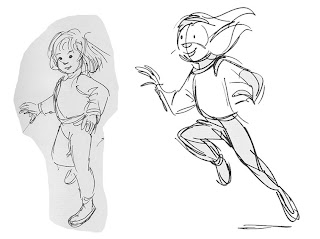This was one of the first articles I ever wrote on gesture drawing. It was posted on Jim Hull's site "sewardstreet.com". Jim was generous enough to go through the trouble and upload it back then. I thought it would be alright to re-post it here on my own site.
I hope alls well.
Imagine fire from within burning your body and all that’s left is a charred outline of what you used to be. Some doctors say it’s not possible and many conspiracy theorists have websites full of pictures and stories about it, who knows maybe it is possible to physically burn up. But when you put this into the context of creativity and passion it’s very possible. Inspiration sparks inside of each and every one of us all the time, whether it’s by another artist’s work, music, or a lover. Either way it’s always there, and more often then not you notice it.
If these sparks of inspiration are ignited spontaneous combustion will occur. It will send you ablaze on the hot trail of making new art and new ideas that you never thought you could do. Thus leaving behind a charred outline of the old artist you used to be.
Let me explain a bit, One of the things I learned from the late, great, Walt Stanchfield was an artistic equation he would always quote during the classes he held at the Walt Disney feature animation studios.
Impression - Expression = Depression
Now I don’t think Walt wanted everyone to think that they were depressed and psychologically challenged. I believe he was talking about being inspired and doing something about it when you are. I figured it this way.
Inspiration from where ever – Execution of art from that inspiration = letting the spark pass you by and not growing as an artist
One of the things that I will always encourage is keeping a sketchbook. Whether you’re an oil painter, story artist, animator, or sculptor, the benefits of watching people and capturing that moment on paper is priceless. A sketchbook to an artist is like batting practice to a home run hitter in the major leagues. Even established artist can grow stale, one of the great ideals of sketching constantly is that it keeps the old gears oiled up. The other important reason is, it adds to the well of resources in your head.
This well in our heads is very important and it feeds off of the inspiration needed to fill it. I always keep a sketchbook, it allows me to reference my well of resources in my head of what things look like or how someone acts when they’re mad or confused or any emotion I may have drawn. Animation artist {particularly story artists, because they still draw by hand} should be sketching all the time in order to keep a knowledge of life they can pull from when they’re doing their work.
The sparks are always there and we need to capitalize on them. The way a man hugs his wife, the way a child plays or even someone reading a newspaper at a coffee shop. As you see these things, a strange burning begins to occur inside of you and lines frantically form on a page and blam! You’re on fire. Before you know it you have pages of art that never existed before and your becoming a better artist for it.
Days have come when I didn’t have my sketchbook and all I can do was kick myself. The best recovery I can think of was reaching for a loose receipt or a napkin and sketch down a quick drawing on it, and take that home with me. The problem with that was, a whole bunch of loose pieces of paper around that I couldn’t keep track of
On the left is a drawing I did in 1994. A niece of mine, who has since grown up, ran passed me and I drew this as quickly as I could. On the right is my quick sketch of what it could’ve been if I were to draw it today. As you can see they are very different and seem to have been done by two very different artists. If you’ve read any of Walt’s “Words of Wisdom” handouts he would take artist’s sketches and give little critiques of them. These critiques and examples were valuable and great to learn from. This is the sort of thing that will continue to do.

The first drawing seems to lack some life and energy the arms seem to be a little stuck into the body, at least her right arm for sure. The legs seem to be a little stiff and there’s hardly any action to the pose. In the second drawing it feels like she’s going to go into another pose. All the lines are drawn in rhythm to get the whole body working together for the action of running. Life seems to be happening in the second drawing as opposed to life frozen in the first. I will get into it a bit deeper as we go along in the coming lessons, but for now enjoy my embarrassing drawing from 1994.
Anyhow, the most important thing I’d like to stress in this writing is, be ready to fuel the spark inside of you, and spontaneously combust into a new artist and leave the charred old artist behind! The sparks will come and if you let them pass, you might want to kick yourself when you wonder, “Why am I not getting any better?”














